The bond between dogs and humans can be incredibly strong. But can our furry best friends actually tell when a new baby is part of their human family? The answer is yes!
Dogs’ powerful sense of smell, observant nature, and loyalty to their people mean they absolutely recognize a new baby as a member of the pack.
In this blog post we will explore can dogs tell a baby is related to their owners.
Read on to learn all the ways dogs pick up on the connection and relationship between new babies and .
Can Dogs Tell A Baby is Related to Their Owners
It may seem surprising, but dogs absolutely can tell when a new baby is related to their owners and part of their family.
Their strong sense of smell allows them to detect the similarity in scent between a baby and the parents.
Their observations of the changes and new routines surrounding the baby also help clue them in.
Dogs also pick up on cues from their owners‘ interactions with the new arrival.
Though they don’t conceptualize relationships exactly like humans do, dogs’ loyalty and pack mentality mean they have an innate ability to identify a human baby as a new member of their family based on what their nose, eyes and instincts tell them.
Do dogs know when a baby is a family member
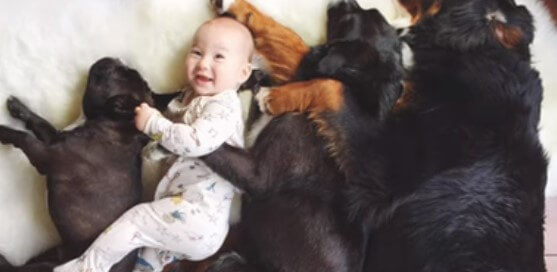
Dogs can definitely tell when a baby is a new member of their family. Here’s how:
- Scent – Dogs have an incredibly strong sense of smell. They can pick up on the new baby’s scent and will associate that with being part of the family pack. The baby will smell similar to the parents, so dogs recognize the connection.
- Sounds – Dogs get attuned to a baby’s cries, coos, and gurgles. They learn these are sounds that are now part of their household.
- Routine changes – Dogs are very observant of schedules. They will notice the changes that revolve around a new baby like waking up at night, different walking times, etc.
- Parental cues – Dogs look to their owners for how to respond to major events. If owners act lovingly toward the baby, dogs take their lead and adjust.
- New furniture/gear – When dogs notice cribs, playpens, highchairs etc. they realize something new has joined the home.
- Less attention – Many dogs will feel confused or jealous when they get less attention after a new baby. But this helps them understand the baby is now important.
- Bonding time – When dogs are allowed to gently play with/snuggle a baby, they bond with the new family member.
Dogs don’t conceptualize family relationships the exact same way humans do.
But their powerful senses and loyalty definitely make them aware of a new baby’s arrival and status in the pack.
They can pick up on the relatedness through scent, routine, environment and more.
Can dogs sense when a woman is pregnant before she knows?
Yes, there are many reports of dogs detecting pregnancy before the woman herself knows.
Here’s how dogs might pick up on a pregnancy:
- Change in hormones – Dogs can smell the increase in hormones like estrogen and progesterone even in early pregnancy. Their noses detect the faint whiffs we don’t notice.
- Morning sickness – Dogs may respond to signs of nausea like more time in bed, different food choices, etc. They seem attuned to subtle changes.
- Behavior changes – Dogs read body language and pick up on moods. A woman’s disposition is altered in pregnancy – more naps, less active play.
- Physical changes – Shifting posture, weight gain and increased blood volume change a woman’s gait and appearance. Dogs are very visual readers of such changes.
- Baby sounds – Amazingly, dogs may hear subtle sounds from the fetus through ultrasound frequencies and increased blood flow.
- Maternal instinct – Female dogs who have had a litter may identify and empathize with a woman’s emerging maternal feelings and instincts.
While dogs don’t conceptualize pregnancy the way we do, their loyalty and devotion definitely make them aware on some level of the changes taking place inside their pregnant human companion. They notice differences and tune in closer to care for and protect.
How can you prepare your dog for the arrival of a new baby?
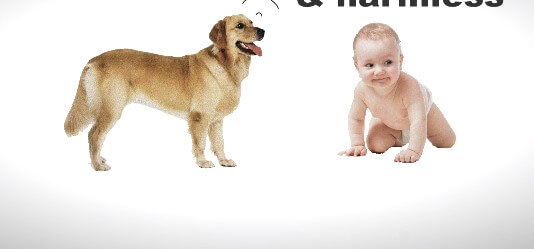
Here are some tips for getting your dog ready before baby arrives:
- Start early – Begin exposing your dog to baby items and sounds a few months in advance so it’s not shocking later.
- Stick to routine – Keep walking, feeding, playing with your dog on a regular schedule. This provides comfort and reassurance.
- Provide exercise – Give your dog plenty of activity to avoid acting out and release energy. This will be harder later when caring for a newborn.
- Train basic commands – Work on reinforcing commands like “sit”, “drop it”, etc. to remind your dog you’re still the pack leader after the baby comes.
- Expose to baby cries – Use recordings to let your dog get used to the new sounds so they aren’t frightening. Associate with rewards.
- Change schedule – Shift when you walk, feed, or interact with your dog to simulate a baby disrupting the current routine. Make the adjustments gradual.
- Limit access – Keep your dog out of the new baby’s room or limit access so the environment doesn’t feel suddenly overwhelming or off-limits.
- Give attention – Make sure to still show your dog affection and care with petting, treats, and play to avoid jealousy of the baby consuming your focus.
- Introduce smells/sounds – Let your dog experience the baby’s blankets, toys and other smells to begin positive association before meeting the baby.
With preparation and training, you can minimize the disruption your dog feels when the baby enters the home, and pave the way for a friendly relationship between them.
How can I introduce my dog to my newborn baby?
Here are some tips for gently introducing your dog to your newborn:
- Have your partner hold the baby while you give your dog affection. This avoids jealousy and lets them warm up to the baby’s smells.
- Keep initial interactions very calm and mild. Don’t allow jumping or roughhousing near the baby.
- Allow the dog to sniff the baby’s hands or feet while you hold the baby securely. Let them make the connection slowly.
- Place a blanket the baby has been swaddled in near your dog’s bed. Allow them time to get used to the scent.
- Consider having a favorite treat or toy for your dog on hand to distract them and keep the interaction positive.
- Use calm verbal affirmations like “Good boy!” when your dog shows polite interest in the new arrival.
- Correct unwanted behaviors immediately and firmly to establish rules around the baby. But stay composed.
- After the initial introduction, supervise all interactions but allow the dog to acclimate to the baby at its own pace.
- Schedule special one-on-one time with your dog for play and affection without a baby to avoid resentment.
- Be alert for signs of stress in your dog like panting, yawning, restlessness and respond with breaks.
With patience and by making their needs a priority too, you can help your dog accept and even come to love your precious new family member.
Why might my dog be jealous of my new baby?
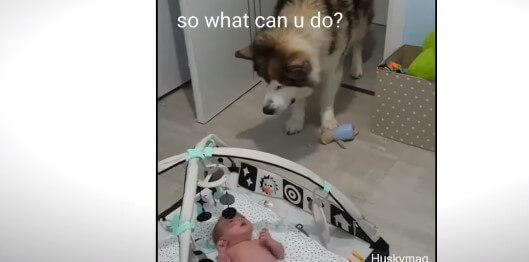
It’s common for dogs to show signs of jealousy over a new baby. Here are some of the reasons why:
- Less attention – Your dog was used to being the center of your world. A new baby means substantially less time focused directly on them.
- Change in routine – Dogs thrive on regular schedules. A baby disrupts mealtimes, walk time, play time, and sleeping habits.
- New smells/sounds – The new sights, sounds and smells of a baby can be overwhelming or stressful for a dog.
- Crying triggers – A baby’s crying can frustrate dogs as they don’t understand the reason for loud outbursts.
- Unfamiliar handling – Dogs have to adjust to kids touching, poking or grabbing them as babies explore.
- Safety measures – Keeping dogs out of the nursery or limiting access can make them feel isolated or punished.
- Owner preoccupation – You will be worried about meeting the baby’s constant demands. Dogs sense when your focus has shifted.
- Less freedom – Dogs used to having full run of the home may now find areas restricted or off-limits for baby safety.
- Displaced status – After being “top dog”, your pet must now adapt to lower pack status vs the new human arrival.
With patience and care, make sure to keep meeting your dog’s needs amid the major life change of a new baby. This will help avoid or minimize any jealousy.
What are signs of stress in dogs when a baby arrives?
Here are some behaviors that signal your dog may be stressed by the new baby:
- Excessive barking or whining – This could indicate fear, confusion or trying to seek attention.
- Pacing or restlessness – Your dog may seem anxious and not able to settle down.
- Withdrawing – Hiding under furniture or avoiding the baby may signal your dog is uncomfortable.
- Loss of appetite – The disruption to routine can cause a dog to lose interest in food or treats.
- Aggression – Growling, snapping or baring teeth warrant an immediate intervention. Do not ignore warning signs.
- Destructive behavior – Chewing, soiling in the home and other acting out reflects your dog is on edge.
- Excessive licking – Dogs may lick compulsively as a self-soothing mechanism.
- Sleep changes – Lack of sleep or unusual sleep patterns show an inability to relax.
- Appeasing gestures – Lip licking, yawning, tail lowering mean your dog is uneasy.
- Shedding – Dogs may shed excessively due to heightened stress hormones.
Make sure to respond to stress signals appropriately by giving your dog attention, exercise breaks, training reinforcement and veterinary guidance if needed. This will help manage the transition to a calmer household.
How can I help my dog bond with my new baby?
There are lots of ways to help facilitate positive bonding between your dog and new baby:
- Allow sniffing – Let your dog gently smell the newborn to get familiar with this new little human.
- Take it slow – Don’t force interactions. Allow your dog to warm up at their own pace.
- Share toys/blankets – Allow your dog to get used to the new smells in your home by smelling the baby’s blankets and soft toys.
- Provide affection – Give your dog lots of praise and petting when they show polite, gentle interest in the baby.
- Capture calm moments – When your baby and dog are both relaxed in the same room, reward your dog with treats.
- Include your dog – If bottle feeding a baby while watching TV, let your dog relax beside you to feel included.
- Stroller walks – Take your dog for a walk with the stroller so they get exercise with you and baby.
- Teach patience – Work on training your dog to settle down and wait for attention to prepare them for baby’s needs coming first at times.
- Minimal disruption – Keep your dog’s routine of meals, walks and playtime as consistent as possible.
- Regular check-ins – Make sure to give your dog adequate alone time and affection each day. Don’t let them feel displaced.
With time and positive association, your dog can form a sweet and protective bond with the new human in your home.
Why might my dog be aggressive toward my new baby?
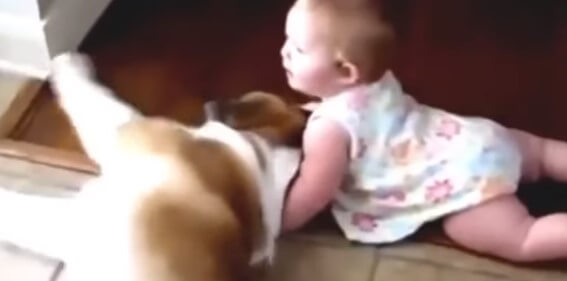
There are a few potential reasons a dog may act aggressively toward a new baby:
- Jealousy – They may resent the baby for disrupting routines and taking your attention away from them.
- Territorial – The baby’s sounds, smells and belongings can seem intrusive. They may see the baby as an “invader”.
- Protective – Some dogs become overly defensive of their owner as the “pack leader”.
- Instinct – Small, erratic movements and sounds can trigger a dog’s prey drive instincts.
- Uncomfortable – Babies do things that make dogs anxious or upset, like grabbing fur, tails or ears.
- Pain response – A baby’s poking fingers or grabbing could cause a pained nip or bite.
- Training issues – Dogs without proper manners, boundaries or socialization may react negatively.
- Fear – Fast movements and loud cries can scare some dogs, causing them to be fearful.
- Maternal stress – Female dogs who have had puppies may see the baby as a threat to their own babies.
While some dogs naturally embrace a new baby, others may need more guidance and training. Aggression should always be addressed immediately by a professional to keep the baby safe.
What precautions should I take when introducing my dog to my infant?
Here are some key precautions when introducing a dog and an infant:
- Supervise all interactions 100% of the time. Do not leave them alone even for a moment.
- Make sure your dog is up-to-date on vaccines and healthy before the baby arrives.
- Establish or refresh rules and boundaries with your dog using positive reinforcement.
- Pick up and restrain your baby if your dog seems overly excited. Redirect their energy if needed.
- Never allow the dog to be near the baby when eating, playing with toys/bones or sleeping.
- Do not allow the dog to jump, paw at, or lick the infant’s face.
- Position yourself between dog and baby if the dog shows signs of anxiety or aggression.
- Keep face-to-face interactions brief at first so neither gets overwhelmed.
- Provide a baby-free safe space for your dog to relax away from the stimulation.
- Ask children in the home to refrain from yelling or running near the dog and baby.
With preparation, rules and supervision, you can introduce your new arrival while also keeping your furry family member feeling safe and secure.
What are some dog breeds better suited for homes with babies?

Some dog breeds often do better around babies and young children. Good family dogs tend to share these traits:
- Friendly – Breeds like Labs, retrievers and poodles are typically social and affectionate with kids.
- Patient – Dogs like bulldogs, Bernese mountain dogs, and mastiffs are usually tolerant of handling and poking.
- Calm – Breeds that don’t tend to be high-strung like St. Bernards and Cavalier King Charles spaniels are safer choices.
- Loyal – Devoted breeds like Newfoundlands who bond closely to families tend to watch over babies.
- Trainable – Intelligent breeds like shepherds and collies who enjoy training respond well to commands around children.
- Non-herding – Herding breeds may nip or chase so avoid border collies, heelers, etc.
- Size – Larger breeds can knock over kids but extra small breeds are more fragile around grabby fingers.
- Good maternal skills – Female dogs with strong mothering instincts often nurture babies.
Supervision is still required, but some breeds are naturally more inclined to excel as part of a family with small children due to their amazing temperaments.
How can I manage both my dog’s needs and my baby’s needs as a new parent?
Balancing both your new baby’s needs and your dog’s needs takes effort but is definitely achievable:
- Stick to a schedule – Keep your dog on a regular routine for feeding, walks, playtime, training, etc. Consistency is reassuring.
- Meet exercise needs – Make sure your dog receives adequate outdoor time and activity to release pent-up energy.
- Provide attention – Set aside focused one-on-one affection time with just you and your dog daily.
- Include your dog – Allow your dog to relax in the same room with you and baby for small periods of time.
- Train for alone time – Reinforce stay commands and independent play so your dog is comfortable when you must focus on the baby.
- Offer interactive toys – Rotating puzzle toys, chews, and food puzzles keeps your dog engaged when alone.
- Ask for help – Hire a dog walker or enlist family to help provide your dog exercise and companionship.
- Keep space for your dog – Ensure your dog still has their own familiar bed and toys in an area just for them.
- Monitor for stress – If you notice signs of anxiety like chewing or soiling, consult a trainer or veterinarian.
- Plan ahead – When running baby errands, make sure your dog’s needs are met with a potty break, crate time, etc.
With flexibility, preparation and commitment to their routine care, you can help your loyal companion adjust to your bundle of joy!
At what age can babies and dogs safely interact?
It’s generally recommended to wait until a baby reaches these milestones before interacting with dogs:
- 2 months old – Babies can start visually tracking dogs and recognizing them compared to other objects. Physical interactions are still very limited.
- 6 months old – Babies have better head and neck control and can reach for a dog. Can begin introduction with close supervision and calm, gentle dogs. Avoid face licking.
- 9 months old – Babies begin crawling and pursue dogs out of curiosity. This access requires extra vigilance and training from dog owners not to allow chasing or mouthing. Keep dogs calm.
- 12 months old – After their first birthday, toddlers can carefully begin to pet gently, feed treats and play gentle fetch games while seated and assisted by adults. Maintain close monitoring.
- 2 years old – Toddlers can now follow simple rules like not bothering a dog who is eating or sleeping. Still no unsupervised time together, but interactions are safer.
- 3 years old – Preschoolers can help participate in aspects of dog care like feeding and walking on leash with assistance. Direct supervision is still required though.
- 6 years old – Children are now able to show responsible pet ownership. Dogs and kids can generally interact safely with some independence but parents should still monitor frequently for safety.
The right age ultimately depends on the child, dog and type of contact. Introducing babies and dogs should always be an incremental process based on meeting developmental milestones.
What are some tips for preventing dog bites with a new baby?
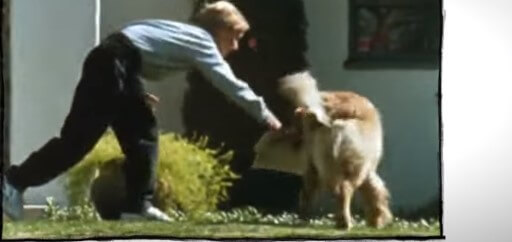
To avoid dog bites around a newborn, focus on the following:
- Training – Practice commands like “leave it” and “settle” so your dog has self-control skills. Reward calm behavior generously around the baby.
- Supervision – No interaction should happen without an adult present to intervene if needed. Keep dogs on leash when the baby is on the floor.
- Approach slowly – Let greetings happen at the dog’s pace. Avoid letting babies crowd dogs’ space.
- Remove access – Use baby gates so dogs don’t have free access to the baby’s room or toys. Feed dogs separately.
- Reduce surprises – Loud noises and quick movements can startle dogs, so handle the baby gently.
- Provide an outlet – Make sure your dog has a safe space they can retreat to, away from the baby. Give them physical and mental exercise daily.
- Socialization – Ensure your dog has been properly socialized to accept handling, nail trims, tail tugs etc. without reacting negatively.
- Confine safely – Use crates or pens to separate dog and baby during boisterous play times so no accidental scratches or bites occur.
- Stay attentive – Notice signs of stress or discomfort in your dog and act before warning growls or bared teeth occur.
- Muzzle train if needed – For severely anxious or reactive dogs, introduce a basket
Conclusion
Dogs have an incredible ability to pick up on the subtle cues that allow them to identify a new baby as part of their human family.
Their sensitive noses detect the infant’s scent similar to the parents. Their eyes notice the changes in furniture, gear, and routine that center around the new arrival.
Their ears tune into the different sounds like cries and gurgles that become part of the household.
While dogs don’t conceptualize family exactly the way humans do, their observational skills and pack mentality mean they absolutely recognize who is part of their inner circle.
Bringing home a new baby is a major adjustment for everyone, including your faithful pooch.
However, understanding how dogs identify babies as family members can help you take steps to facilitate a smooth transition.
With time, positive association, routine care, and guidance, a man’s best friend can form an incredible bond with your little one.
Supervision is always key, but don’t be surprised if before long your dog becomes completely smitten with the new pack member.
Their loyalty, protectiveness, and ability to understand family connections despite species differences are some of the many reasons we love our canine companions so much.








